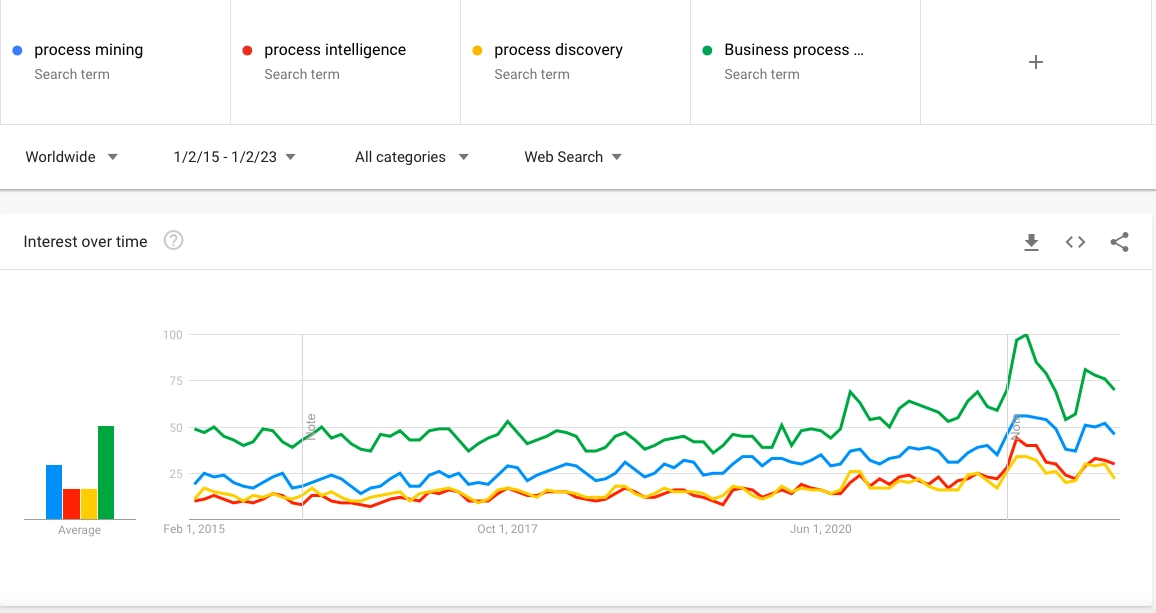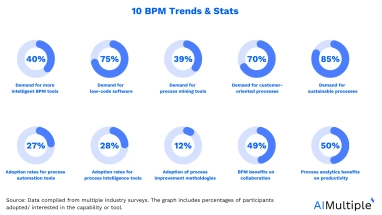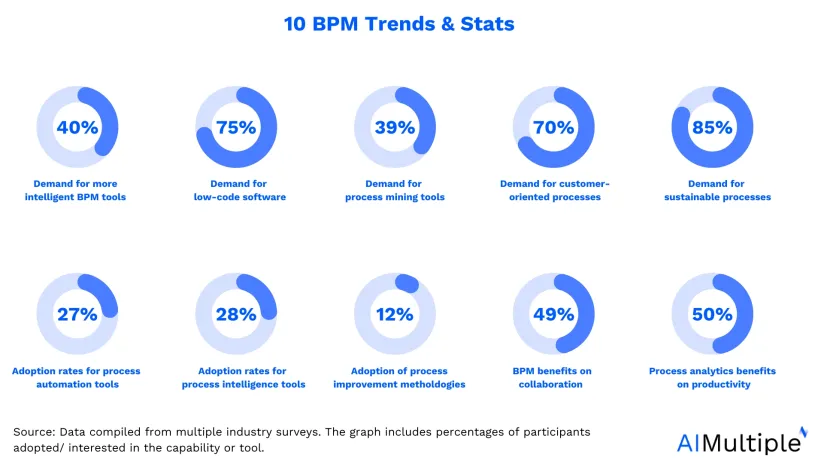Latest BPM statistics show that only 15% of firms were happy with the result of their process improvement efforts. Therefore, business leaders and BPM experts must closely watch the competitive landscape and market requirements before choosing a tool and engaging in the projects.
This article covers top 10 BPM trends that shape the future of BPM to help executives make data-driven decisions regarding their investments.
The current state of BPM market
Based on the BPM stats:
- The global business process management market (BPM) is estimated to grow to $14.4 billion in 2025.
- The business executives express an increasing interest in BPM by 73%.
- Firms utilize BPM to manage their tasks by 62% and model their processes by 70%.
1. Hyper-automation streamlines BPM
Hyper-automation is one of the top 12 technology trends. It automates processes, reduces operational costs and improves process efficiency by leveraging intelligent tools such as:
- Robotic process automation (RPA)
- Artificial intelligence (AI)
- Process mining & Task mining
- Digital twins & Digital twins of an organization (DTO).
- Low-code and no-code development
These platforms streamline the complexity of BPM initiatives; therefore, businesses rank process mining (by 39%) and automation tools (by 56%) as the top BPM software they want to leverage.
For instance, hyper-automation technologies can help learn and control an organization’s business processes better by offering a holistic and contextual understanding of operational process execution and predicting problems to solve and adapt in time. It is estimated that organizations will adopt some of these technologies to redesign processes and reduce operational costs by 30% by last year.
Moreover, hyper-automation deploys a bot to replicate manual activities and predictable tasks to reduce errors and improve operational efficiency. Thus, hyper-automation can ensure that employees engage in value-added tasks. This is why implementation rates for robotic process automation (RPA) accelerated by 53% as the latest RPA stats have shown.
2. Low code/No code democratize BPM for all
Low code statistics show that, 75% of firms will rely on low or no-code technologies this year.
Low-code/No-code systems are code-free platforms with drag-and-drop functionalities. Low code systems can reduce efforts and time allocated for improving and automating processes.
Typically, BPM projects require a large team with business process analysts and costly or complicated solutions.
However, low-code/no-code systems can tackle this issue by democratizing BPM because it automatically generates simple maps and dashboards where everyone can easily drive insights. As a result, it enables all relevant parties to understand the business process and participate in the projects.
Discover top Low-code/No-code development platforms.
3. Intelligent BPM is at the steak
40% of business leaders consider replacing their current BPM tool with more intelligent software in the following two years.
On typical BPM tools, it would take time and resources to wrangle data to upload on the platform, derive insights from the analytics, and incorporate them into the strategy and process improvement.
Today, BPM technologies are converting into more predictive and prescriptive technologies thanks to data integration and machine learning. These systems are known as intelligent or AI-powered BPM, containing technologies as following:
- Process intelligence software such as
- Process Mining
- Task mining
- Digital twins of an organization (DTO)
- Intelligent business process modeling
- Process automation
- Process analytics
These tools leverage operational information to automatically model processes, run analytics and provide suggestions.
For instance, prescriptive process mining and monitoring allow setting alerts or automated actions for selected tasks or repetitive activities. For example, by hyperlinking OTD with the email system, supply chain departments can automatically inform clients of delays via email. This way, employees reduce the time spent on redundant tasks and sending emails while improving customer experience.
Explore smart process management technologies, like:
4. Process mining overtaking the business process management market
With the impact of hyper-automation, low-code/no-code and AI/ML, organizations replace improvement techniques, such as six sigma, with process intelligence.
For instance, in recent years, the number of BPM projects that utilized process improvement methodologies and techniques downsized from 21% to 12% over the last ten years. Meanwhile, the usage of process intelligence tools increased to 28% and process automation to 33%.
A similar trend can be found in Google search since process mining, intelligence and discovery have been parallel to process management (See Figure 1). Such behavior implies that these software are taking over the business process management market, and becoming the key players to manage and improve processes.

Check out comprehensive and constantly updated process mining case studies list to learn more on process mining with its real-life examples.
5. Collaboration is rising as a major BPM benefit
Higher collaboration can increase productivity and customer satisfaction. However, it can be challenging to implement for large enterprises where various teams operate globally.
Besides, it has become a major challenge for small or medium sized businesses after COVID-19 since remote working created the demand for better business process management and collaboration over strategic operations.
Therefore, business process management has been expected to include features to
- Define improvements,
- Set process related alerts,
- Secure document sharing,
- Enable easy communication,
- Streamline issue management and access control.
After all, 49% of business executives view collaboration as the main benefit of their BPM initiative.
6. Real-time business process management tools ensure agility
So far, business process management projects have kept focusing on gathering historical data for understanding and documenting processes accurately. Today, companies focus on real-time monitoring and actual implementation to remain agile and competitive in the market.
BPM solutions contain control-related capabilities and cloud connectivity to complete and monitor business operations anytime and anywhere. Thus, process experts can avoid giant redesign projects and immediately create impactful and fast changes.
Predictive process monitoring is an emerging technology, enabling business users to detect and correct an issue in a shorter time.
7. Process analytics is the new process CEO
Increasing process automation in business processes generates large data providing an ability to capture any details on operations. Consequently, this created a strong demand to utilize these inputs in the business process management market.
Process analytics capabilities will keep rising in the future since it allows industries to monitor and implement improvement steps without relying on large and holistic process redesigns.
Process professionals can develop performance KPIs, such as efficiency, effectiveness and compliance, focusing on cost and time management. These KPIs provide insights to develop strategies, enhancing data-driven decision-making and boosting productivity by 50%. With these insights, BPM teams can easily identify non-valuable tasks and activities like reworks, repetitive actions and unnecessary steps.
8. BPM gaining a customer-oriented focus
Customers point out smooth and connected processes as the reason for higher satisfaction by 70%. Customer-oriented improvements can increase customer satisfaction and economic gains between 20-50%.
On the other hand, 41% of firms that invested in transforming their primary processes complained about how they lacked customer view.
BPM solutions can measure customer effort scores, leverage feedback and map customer journeys to bring clients’ points of view to the BPM project. This way, business leaders and analysts can redesign their primary and secondary operations and revisit their back-office activities to increase customer experience.
9. BPM as the digital transformation enabler
Process transformation can boost profit by 50%. However, employees often stand against digital transformation initiatives due to the high costs (28%) or difficulty to embrace technological innovation (26%).
BPM has been central to transformation efforts, incorporating new technology, developing a new strategy and redefining employee roles.
Today BPM visualizes the relationship between employees, technology and resources. New BPM solutions streamline process analysis, modeling and improvements while providing dynamic maps. These maps bring end-to-end visibility to the processes by containing other details such as KPIs, business rules, roles and documents
10. BPM catching up with sustainability trend
In recent years, another rising trend is the sustainability. 85% of customers indicate that they prefer shopping with environmentally friendly companies, turning major companies into producing and delivering sustainable services and goods.1
Besides, rules and regulations push industries to decrease their negative impact on the environment through several environmental metrics, such as:
- Greenhouse gas emissions
- Emissions intensity
- Circular economy metrics
- Energy type
Large businesses already benefit from artificial intelligence (AI) to achieve sustainability goals. In the close future, we expect intelligent BPM to play a crucial role for ensuring sustainability as well. Business executives can set desired goals or rules as ideal models and estimate compliance levels between these ideal models and their actual processes.
For instance, process mining offers core and additional capabilities, such as compliance checks and root-cause analysis, enabling organizations to develop environmental, social and governance reporting KPIs, monitor compliance issues, and identify the responsible areas, sources and individuals.
Further reading
Explore process mining trends and future of process mining:
Compare process mining tools with our data-driven comprehensive process mining vendor list.
And, if you still have more questions, let us know:




Comments
Your email address will not be published. All fields are required.